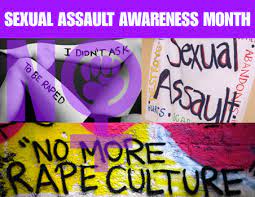Sexual Assault Awareness Month (SAAM)

May 5, 2022
First and foremost, if you are struggling with anything related to sexual assault, please reach out. There are people available to support you. The number for the National Sexual Assault Hot Line is 1-800-656-4673.
Overview
This is a very triggering subject but one that needs to be talked about. Sexual assault has been affecting people since the beginning of humanity. Women and men have been sexually assaulted in many different ways. This is something that needs to be fought against.
Sexual assault has a very long and winding history. The world has come a long way in developing laws and protection to keep men and women safe from sexual abuse. There are many protective laws that have been passed. Women and men have both come together to speak out against sexual assault.
Within this article, the history, current laws and acts, the effects it has on a person, tips for talking to survivors, and resources will be covered.
Please be advised of the following trigger warnings: rape, sexual assault, self-harm, and suicide.
History
Rape is a big part of sexual assault. It is the main thing people think of when they hear the words is rape. Rape laws have a long and winding history. The first law was passed in Babylon way back in 1900 B.C. It was based on the Code of Hammurabi. It stated that if a man were to force sex upon another man’s wife, or a woman who is living in the house of her father, he would be punished with death. Rape was considered theft and vandalism as women were seen as men’s property.
The only reason rape was found to be “morally depraved” was because it hurt the honor of the men that were connected to that woman. This being said, if the woman had no strong ties with a man, people saw no problem with it. Also, the women who were raped were considered “damaged goods” and “no longer viable for marriage.”
However, in the 1600s, an English law changed the way rape was seen and inspired the movements that were created. Rape was redefined as a criminal act. Despite this, rape was only seen as a crime for those outside of the bonds of marriage. Women were also not treated as a victim of rape until the person was proven guilty. They were only a witness and defendant.
On January 24th, 1971, the New York Radial Feminist Group held its first public speak out. While supporting each other, women came together and told their stories. This influenced the Second Wave feminist movement.
Women began marching in Take Back the Night marches and poetry readings became very popular. Writers, such as Susan Griffin started calling rape a “form of mass terrorism.” They wrote about how rape restricted women’s lives as it made them live in terror, unable to go places alone. Anti-rape activists worked to create awareness of the problem by promoting consciousness, support, and legal changes.
Later on, the Bay Area Women Against Rape, or BAWAR, opened the fire two rape crisis centers in 1971. They were located in California and Washington DC. Their goal was to “establish a place where rape and incest survivors could receive quality counseling and the advocacy they need.” It will also be noted that colored women were the first to come out and speak about their experiences. Sexual assault and rape crisis centers are all grouped under rape crisis centers; they both are equipped to handle every situation.
Later on, spousal rape was outlawed and in 1996, the last American state passed anti-rape laws.
Current Sexual Assault Laws and Acts
There are many important acts to learn about. These include the Debbie Smith Act, the Clery Act, the Campus SaVE Act, the SAFER Act, Title IX, and the Victims of Crime Act.
Here is an overview of each of them:
The Debbie Smith Act focused on DNA evidence. The goal was to eliminate the backlog of unanalyzed and untested DNA. They provided resources to process the evidence as well as to add the samples to the national DNA database.
The Clery Act required colleges and universities to become transparent about what is happening on their campus. They are required to fully warn their students of the crimes that have been committed, showing them whether or not they are in danger.
The Campus SaVE Act also focused on colleges and universities. It worked with the Clery Act to increase transparency as well are guarantee rights to survivors, establish disciplinary proceedings, as well as require more education programs.
The SAFER Act is similar to the Debbie Smith Act. It tried to minimize the backlog of DNA evidence to bring more perpetrators to justice.
Title IX provided education institutions, funded by federal funding, to prohibit and minimize discrimination based on sex.
The Victims of Crime Act, or VOCA, helps victims with the costs of receiving help. It focuses on medical bills, counseling services, and lost wages, allowing more people to receive the help they need.
Consent
Another important thing to talk about is consent. Lack of consent comes from forcible compulsion, incapacity to consent, and where any charge of sexual abuse or forcible touching involving someone unable to consent. That being said, what makes someone unable to consent? Someone who is less than seventeen years of age, mentally disabled, mentally incapacitated, or physically helpless. Also, when someone has clearly expressed they do not consent. All of that means a lack of consent, making any sexual act illegal and punishable. (New York Penal Law §130.05.) A mandated reporter has to report when someone who cannot consent is involved. This mainly focuses on children, the elderly, and the disabled. There are many other legal terms and laws regarding parental rights, confidentiality laws, and lawfully owned DNA.
Effects of Sexual Violence
Sexual assault affects people in multiple different ways. Depression, flashbacks, and PTSD are the most common. Anxiety, fear, and stress will also make it difficult for a person who has experienced sexual assault. Self-harm and substance abuse are only a couple of things that victims will turn to coping with. Disassociation, panic attacks, eating disorders, and sleep disorders are all very commonly seen. In some extreme cases, some even commit suicide.
There are some physical effects as well. Sexually transmitted diseases and infections can be passed along. Some of these, such as HIV, can not be cured and will stay with that person for the remainder of their life. About 5% of rape victims become pregnant.
Tips for Talking to Survivors
It is important to be supportive and non-judgmental. Providing resources (some are below), encouraging to seek medical attention, and reporting the crime are all good things to do to start helping someone who has come to you. Remember that many survivors feel guilty and shameful so it’s important to tell them you believe them and that what happened wasn’t their fault. Telling them it took courage to tell you is also a good thing to say. Showing them that you care and will be there to talk to, if you’re able, will show them support. Remind them that they didn’t deserve what happened to them as often they will feel like they brought it on. Checking in periodically will be vital. They may not tell when they are struggling so make sure to check in on them and remind them that you are still there. Showing continued support will ultimately allow them to heal. Knowing resources to help them will also help you. Make sure you stay informed on the updates of resources so that you can provide them if needed.
Resources
If you have been or know someone who was a victim of sexual assault, here are some resources to reach out to.
National Sexual Assault Hotline: 1-800-656-4673
Other Resources:
https://www.rainn.org/resources
National Suicide Prevention Hotline: 800-273-8255
Citations
CL;, H. M. M. R. H. S. K. D. G. B. (n.d.). Rape-related pregnancy: Estimates and descriptive characteristics from a national sample of women. American journal of obstetrics and gynecology. Retrieved May 11, 2022, from https://pubmed.ncbi.nlm.nih.gov/8765248/#:~:text=Results%3A%20The%20national%20rape%2Drelated,result%20from%20rape%20each%20year.
Flagler, B., & Flagler, B. (2019, December 13). A Brief History of Rape Law. The Feminist Poetry Movement. Retrieved May 11, 2022, from https://sites.williams.edu/engl113-f18/flagler/a-brief-history-of-rape-law/#:~:text=The%20fist%20rape%20law%20emerged,to%20death%E2%80%9D%20(Gold).
Management. (2011, May 9). History of the movement. Management. Retrieved May 11, 2022, from https://www.wcsap.org/advocacy/program-management/new-directors/history/history-movement
Sexual assault laws and court decisions. RAINN. (n.d.). Retrieved May 11, 2022, from https://www.rainn.org/sexual-assault-laws-and-court-decisions
Tips for talking with survivors of sexual assault. RAINN. (n.d.). Retrieved May 11, 2022, from https://www.rainn.org/articles/tips-talking-survivors-sexual-assault
What are rape crisis centers and how have they changed over the years? National Sexual Violence Resource Center. (n.d.). Retrieved May 11, 2022, from https://www.nsvrc.org/blogs/what-are-rape-crisis-centers-and-how-have-they-changed-over-years

